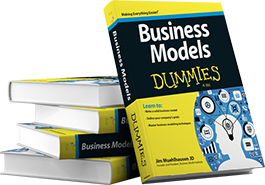The difference between the business model, framework and architecture
An interesting question from Marsha Campbell, HR Officer at National Commercial Bank Jamaica Ltd landed in my inbox the other day:
I noticed on your website you explained the difference between a model and a business plan. I would like to know what is the difference between the model, framework and architecture. Most sites that attempt to answer this question tend to be IT specific. Would you be able to shed some light?
Our business model research specialist, Huss Sadri, came up with the following answer.
A business model describes the rationale of how an organization creates, delivers, and captures value (economic, social, or other forms of value). The process of business model construction is part of business strategy and the design of organizational structures. Thus the essence of a business model is that it defines the manner by which the business enterprise delivers value to customers, entices customers to pay for value, and converts those payments to profit: it thus reflects management’s hypothesis about what customers want, how they want it, and how an enterprise can organize to best meet those needs, get paid for doing so, and make a profit.
Ultimately, the business model of a company is a simplified representation of its business logic. It describes what a company offers its customers, how it reaches them and relates to them, through which resources, activities and partners it achieves this and finally, how it earns money. The business model is usually distinguished from the business process model and the organization model.
A business model can be described by looking at a set of building blocks such as for example:
- Market Attractiveness of the Business
- Value proposition
- Revenue Distribution
- Sales Performance
- Competitive Advantage
- Key resources
- Cost structure
- Pitfalls & Risks
- Exist Model
- Customer Value
Business architecture is a part of an enterprise architecture related to corporate business, and the documents and diagrams that describe that architectural structure of business. Business Architecture articulates the functional structure of an enterprise in terms of its business services and business information. The key views of the enterprise within the business architecture context are:
- Business Strategy view: captures the strategic goals that drive an organization forward. The goals may be decomposed into various tactical approaches for achieving these goals and for providing traceability through the organization.
- Business Capabilities view: describes the business functional abilities expressed via business services of an enterprise and the sections of the organization that would be able performing those functions.
- Business Knowledge view: establishes the shared semantics (e.g., customer, order, and supplier) within an organization and relationships between those semantics (e.g., customer name, order date, supplier name).
- Business Operational view: defines the set of strategic, core and support operational structures that transcend functional and organizational boundaries. It also sets the boundary of the enterprise by identifying and describing external entities such as customers, suppliers, and external systems that interact with the business. The operational structures describe which resources and controls are involved.
- Organizational view: captures the relationships among roles, capabilities and business units, the decomposition of those business units into subunits, and the internal or external management of those units.
Business frameworks Operationally, the business framework generally describes the corporate organization or management structure or may generally outline company policies or an organization might develop a framework to achieve a particular goal or An innovations framework may outline policies, procedures and management changes the company will use to achieve innovation and growth etc.
Effective leaders provide a business framework in which people and business partners can work efficiently and effectively, both individually and collectively, and succeed for mutual benefit. A framework comprises:
- goals and strategies,
- policies,
- organization and culture,
- relationship contracts and arrangements,
- business processes,
- roles,
- tools,
- systems,
- objectives and
- Measures and incentives.
A good business framework creates an organizational environment in which people think and act for themselves, yet collaborate to achieve common goals and objectives.









